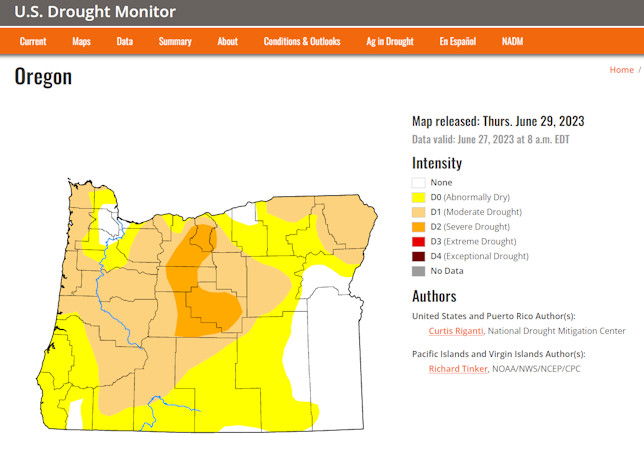Wet spring can’t head off early C.O. irrigation district water curtailments due to dwindling Deschutes flow

REDMOND, Ore. (KTVZ) -- Despite experiencing heavy rainfall and a series of spring storms, the majority of Deschutes and Crook counties remain entrenched in a state of severe drought, according to the U.S. Drought Monitor. Consequently, Deschutes Basin irrigation districts are preparing for the need to curtail water as early as mid-July due to the dwindling natural flow in the Deschutes River.
Jeremy Giffin, Deschutes Basin watermaster for the Oregon Water Resources Department, highlighted the significance of the situation, stating, "While recent rainfall has provided some relief, the long-term recovery requires several years of above-average precipitation. Unfortunately, the snowpack we achieved during the winter is not resulting in a significant snowmelt runoff translating to live flow.”
Snowmelt from accumulated snowpack is an important source of water for farmers.
"Districts relying solely on live flow are expected to experience water shortages, while those utilizing stored water will need to rely on these supplies,” said Craig Horrell, president of the Deschutes Basin Board of Control, which issued this news release Wednesday. “Ultimately, this means reduced water availability for district patrons and impacts on fish and wildlife."
The irrigation districts are closely monitoring the situation, with Arnold, Tumalo, Central Oregon, and Lone Pine irrigation districts adjusting flows due to the declining natural flow in the Deschutes River.
In light of these developments, the districts strongly advise irrigators to proactively plan for potential water supply shortages during the summer months.
Addressing the challenging circumstances faced by the community, Horrell emphasized the irrigation districts’ commitment to implementing long-term solutions.
"The frequency and intensity of these drought events pose extraordinary difficulties for farmers, fish, wildlife, and community members," he stated. "We continue to focus on replacing leaky, open canals with closed pipes, allowing water saved from seepage below and evaporation above to support agricultural needs and contribute to the preservation of our river and wildlife."
The Deschutes Basin Board of Control urges patrons to stay informed about the evolving situation and remain proactive in implementing water conservation measures.
The Deschutes Basin Board of Control comprises eight irrigation districts, namely Arnold, Central Oregon, Lone Pine, North Unit, Ochoco, Swalley, Three Sisters, and Tumalo. Together, these districts provide water to over 7,600 farms and ranches, as well as local cities, parks, and schools.
For more information and updates, please visit www.dbbcirrigation.com